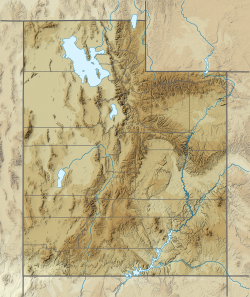Top Qs
Timeline
Chat
Perspective
Franklin Butte
Mountain in Utah, United States From Wikipedia, the free encyclopedia
Remove ads
Franklin Butte is a 5,179-foot-elevation (1,579-meter) summit in San Juan County, Utah, United States.
Remove ads
Description
Franklin Butte is situated 15 miles (24 km) west of Bluff, Utah, in the Valley of the Gods, on land administered by the Bureau of Land Management.[3] Precipitation runoff from this iconic landform's slopes drains to the San Juan River via Lime Creek. Access to the butte is via the 17-mile Valley of the Gods Road which passes near this butte. Topographic relief is significant as the summit rises nearly 400 feet (122 meters) above the surrounding terrain in 0.1 mile (0.16 km). This landform's toponym has been officially adopted as Franklin Butte by the United States Board on Geographic Names.[2] It is also known as "Sitting Hen" by some rock climbers, however this should not be confused with nearby Setting Hen Butte.[1] The first ascent of the summit was made in 1990 by John Middendorf and Melissa Wruck.[4]

Remove ads
Geology
Franklin Butte is composed of two principal strata of the Cutler Formation. The bottom layer is slope-forming Halgaito Formation and the upper stratum is cliff-forming Cedar Mesa Sandstone.[5] Cedar Mesa Sandstone is the remains of coastal sand dunes deposited about 270 to 300 million years ago, during the Wolfcampian (early Permian).[6] The buttes of Valley of the Gods are the result of the Halgaito Formation being more easily eroded than the overlaying sandstone. The valley floor is Honaker Trail Formation.[7]
Remove ads
Climate
Spring and fall are the most favorable seasons to visit Franklin Butte. According to the Köppen climate classification system, it is located in a cold semi-arid climate zone with cold winters and hot summers.[8] Summers highs rarely exceed 100 °F (38 °C). Summer nights are comfortably cool, and temperatures drop quickly after sunset. Winters are cold, but daytime highs are usually above freezing. Winter temperatures below 0 °F (−18 °C) are uncommon, though possible. This desert climate receives less than 10 inches (250 millimeters) of annual rainfall, and snowfall is generally light during the winter.
See also
References
External links
Wikiwand - on
Seamless Wikipedia browsing. On steroids.
Remove ads



